Food
Follies of the Madmen #328
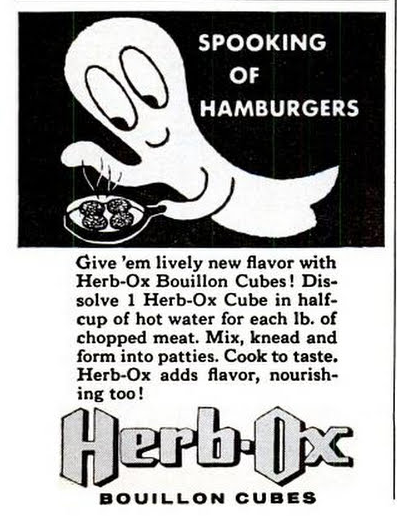
As you can see, this ad appeared in the April issue of EBONY magazine, thus rendering any possible connection to Halloween, the time of ghosts, utterly irrelevant. What is the excuse for the pun, then? Because Herb-Ox represents the ghost of a cow? It's utterly arbitrary and unseductive and not germane to the product. Yet some ad guy obviously thought it was genius.
Posted By: Paul - Wed Oct 11, 2017 -
Comments (3)
Category: Business, Advertising, Products, Food, Superstition, 1960s
Tiny Food
Artist Tom Brown creates tiny food in his tiny kitchen. He recently became famous on the Internet when George Takei shared the video below on Facebook, leading to 2.8 million views. Check out Tom's website here.
Posted By: Alex - Wed Oct 04, 2017 -
Comments (4)
Category: Food
Easy Does It: Canned Goods Rule
The bad-acid-trip Good Fairy of Canned Vegetables talks about marketplace disruptions and paradigm shifts, and serves as Cupid. Be sure to enjoy the suicidal tomatoes plunging to their canned goods deaths.
Posted By: Paul - Sat Sep 23, 2017 -
Comments (0)
Category: Business, Advertising, Corporate Mascots, Icons and Spokesbeings, Products, Retailing, Food, Cartoons, 1940s
The Exploding Recipe
May 1978: Random House issued a recall of a cookbook, Woman's Day Crockery Cuisine, after realizing that one of the recipes "could cause a serious explosion."The recipe in question was for "Silky Caramel Slices." The problem was that it instructed people to heat an unopened can of condensed milk in a crockpot for four hours. A statement from Random House noted, "If the recipe is followed, the condensed milk can could explode and shatter the lid and liner of the crockery cooker."
What the recipe neglected to mention was that you should add water into the crockpot surrounding the can. Initially I thought you should open the can also, but my wife (who's heard of this technique of cooking condensed milk on a stove top) corrected me. You keep the can closed so that the milk doesn't boil out of the can.
Marilynn Marter, writing in the Chicago Tribune (May 25, 1978) explains:
The conditions that have made this underground recipe successful and therefore popular, especially with children, are water and temperature. By being heated in boiling water, the temperature of the can and milk do not exceed the boiling point. After a few hours of this, the sugared milk turns to a caramel pudding. In the Crockpot, however, especially without water, the temperature can build up rather like a pressure cooker. That was the most immediate cause of the problem.
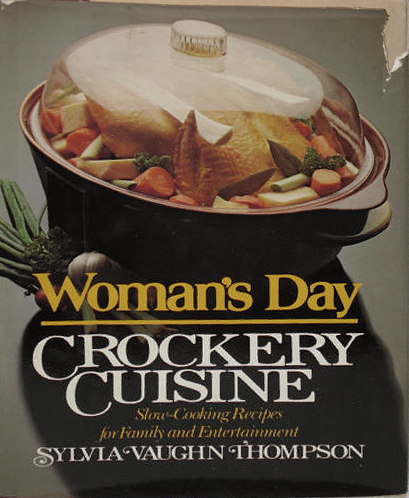
Front Cover
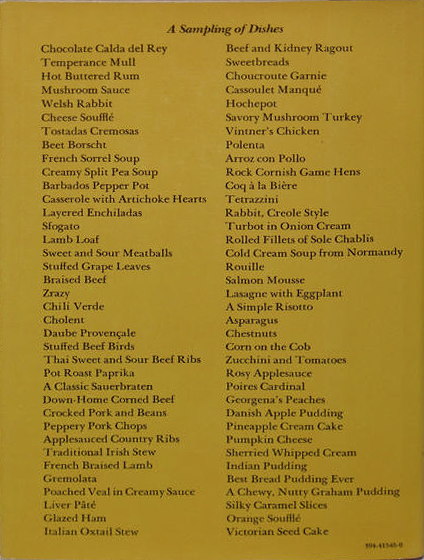
Back cover
The 'exploding' recipe (Silky Caramel Slices) is listed third from bottom, right-hand column.
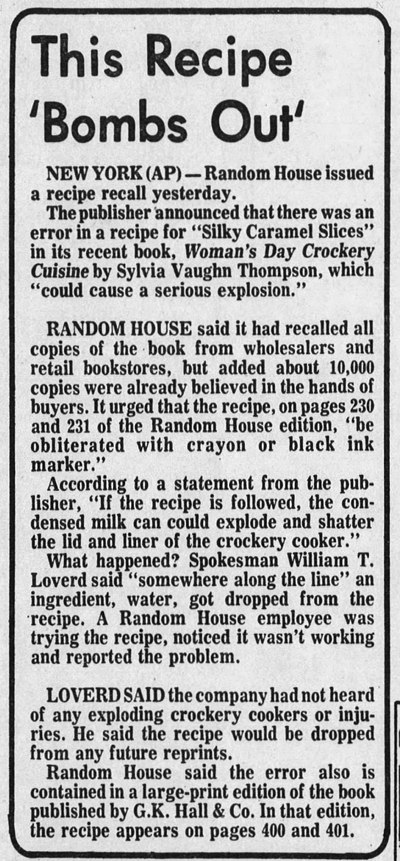
The Tennessean - May 9, 1978
Posted By: Alex - Thu Sep 21, 2017 -
Comments (3)
Category: Food, Cookbooks, 1970s, Weapons
Follies of the Madmen #326
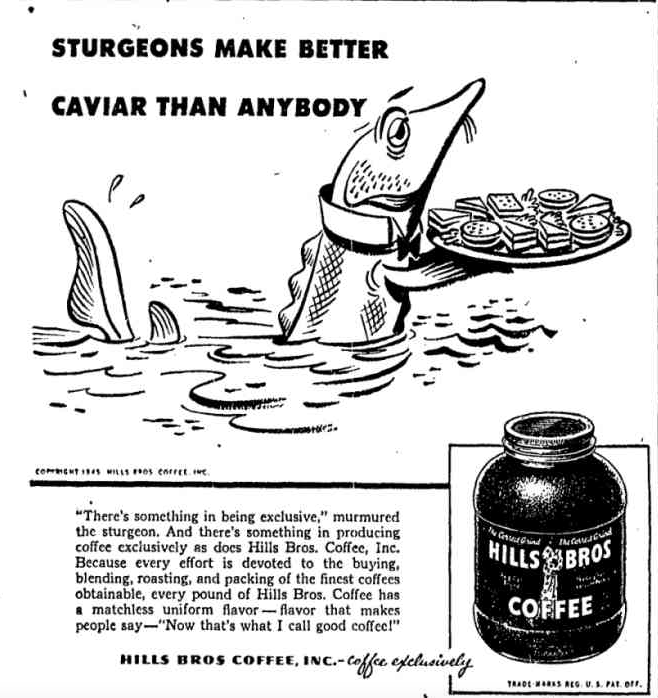
1) Sturgeons are the ONLY ones to make caviar, therefore they are best by default, and the point is moot.
2) The mental juxtaposition engendered by this ad between a fishy taste and the taste of coffee is most unpleasant.
Posted By: Paul - Wed Sep 20, 2017 -
Comments (4)
Category: Animals, Business, Advertising, Products, Food, 1940s
Butter Coffee
I posted five years ago about Norwegian Egg Coffee. But egg isn't the only unusual thing that people add to their coffee. A few years ago, there was a fad for butter coffee, aka Bulletproof Coffee. As the name implies, you mix butter into your coffee. People often add in some coconut oil as well. Apparently the butter binds with the caffeine, giving a longer, more powerful caffeine buzz. According to testimonials, it doesn't taste bad at all.I'd be willing to give butter coffee a try, but I'll give mayonnaise coffee a pass.
Posted By: Alex - Fri Aug 25, 2017 -
Comments (2)
Category: Food, Coffee and other Legal Stimulants
Potato Chip Casserole a la Gorton
WU-vie MJBIRD asks for the winning recipe associated with the first Potato Chip Queen. I found a slightly imperfect OCR of it here!If anyone makes it, please report!
Potato Chips A la Gorton
2 tbs. flour
3 cups coarsely crushed potato chips
1 cup milk
6 medium size carrots
tsp. salt
8 medium size onions
tsp. pepper
2 tbs butter or margarine
[Illegible] cup grated American cheese
Scrape carrots and slice into [Illegible]-inch slices.
Cook until tender in boiling, salted water. Drain.
Pare onions and slice in [illegible]-inch slices. Cook until tender in boiling, salted water. Drain.
Melt butter or margarine in a heavy sauce-pan. Add the flour and blend. Add the milk and cook and stir until cheese is melted.
Arrange half of carrots in bottom of a greased casserole dish. Cover with a layer of crushed potato chips, then with half the onions. Cover with crushed potato chips.
Repeat layers.
Top with sauce mixture and a dash of paprika. Bake in a moderate oven, 350 degrees, for about 20 minutes, or until thoroughly heated and lightly browned.
Makes 5-6 servings.
Posted By: Paul - Tue Aug 22, 2017 -
Comments (1)
Category: Food, Reader Recommendation, 1940s
Sexy Pineapple Diet
This diet from 1970 was simple. Just eat only pineapple for two days every week. On the other days you can eat whatever you want. The book is apparently quite a rarity, because I haven't been able to find any used copies for sale.Over at vice.com, a guy recently tried the diet and claims that he lost 1 kilogram (2.2 lbs) in three days. Which, actually, isn't a lot. Evidently, he was able to find a copy of the book. He also discovered that one of its authors, Sten Hegeler, was still alive, 93 years old. When contacted, Hegeler admitted that not a lot of deep thought went into the concept of the diet:
And a bonus for linguaphiles: The word "erogetic" appears to have been invented for this book. I'm not sure what it means.
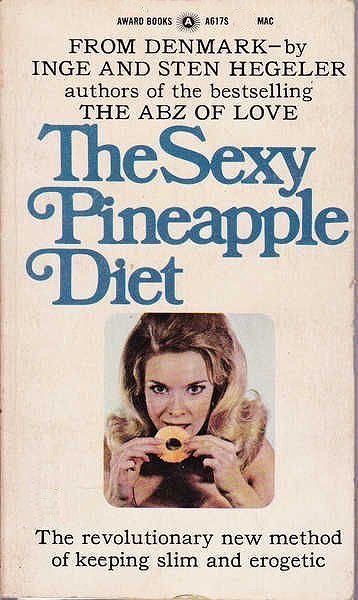
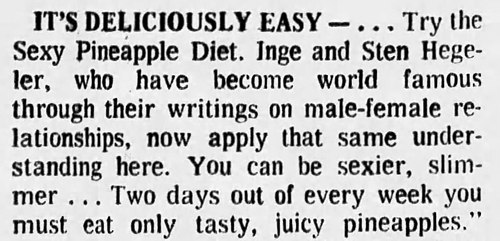
Fort Myers News-Press - Sep 16, 1970
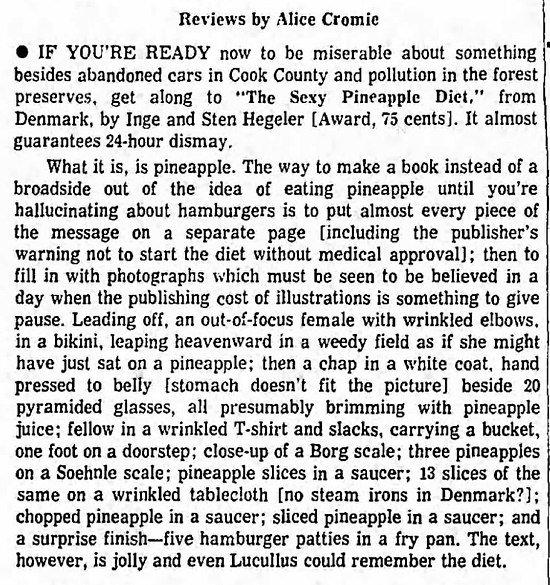
Chicago Tribune - Nov 5, 1970
Posted By: Alex - Wed Aug 09, 2017 -
Comments (6)
Category: Food, 1970s, Dieting and Weight Loss
Limited edition mayonnaise jar
Duke's mayonnaise is celebrating 100 years in business by selling limited edition glass jars of its mayonnaise — as opposed to those plastic jars all condiments come in nowadays.Duke's has rather passionate followers. It's some kind of Southern thing. Southerners LOVE their mayonnaise, especially mayonnaise and tomato sandwiches. And Duke's is held in high regard as being the premier Southern mayonnaise. I've had it, and I agree it's pretty good. It's not a sweet mayonnaise. In fact, it has no sugar in it at all. It's like Hellmanns, but a bit tangier.
Anyway, some people love the stuff so much that they've arranged for their ashes to be stored in a Duke's jar after their death. So if you order the limited-edition jar, that's one thing to do with it once you've eaten the mayo.
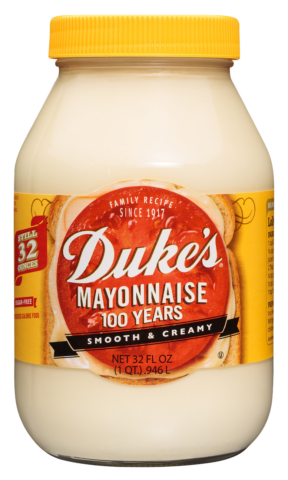
Posted By: Alex - Mon Jul 31, 2017 -
Comments (6)
Category: Death, Food, Mayonnaise
Miniature Cusine
Lots more here.
Article here.
Posted By: Paul - Wed Jul 26, 2017 -
Comments (1)
Category: Enlargements, Miniatures, and Other Matters of Scale, Fey, Twee, Whimsical, Naive and Sadsack, Food, Foreign Customs

| Who We Are |
|---|
| Alex Boese Alex is the creator and curator of the Museum of Hoaxes. He's also the author of various weird, non-fiction, science-themed books such as Elephants on Acid and Psychedelic Apes. Paul Di Filippo Paul has been paid to put weird ideas into fictional form for over thirty years, in his career as a noted science fiction writer. He has recently begun blogging on many curious topics with three fellow writers at The Inferior 4+1. Contact Us |




